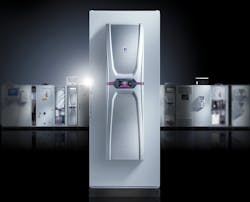Far less mundane than your refrigerator at home letting your grocery app know when you’re running low on eggs, refrigeration in your plant operations could offer a great deal of benefit with improved communications. At Hannover Fair last month in Germany, Rittal highlighted how much more optimized its Blue e+ cooling units and chillers become when capitalizing on the capabilities of the Industrial Internet of Things (IIoT).
The Blue e+ units already consume an average of 70 percent less than their conventional counterparts. But adding some key communications takes the capabilities further. With a near-field communication (NFC) connection, the units can transmit key data to a smartphone quickly and simply. RiDiag III parameterization and diagnostics software uses a USB interface or a network to support efficient system operation, deliver rapid support for maintenance and repairs, and enable in-depth diagnostics. The new communications module also allows the cooling units and chillers to communicate with any higher-level system via OPC UA, Profinet, SNMP, Modbus RTU and CAN Master—enabling predictive maintenance, data analytics and more.
At Hannover, Rittal showed off two use cases—with Siemens MindSphere and IBM Watson—to demonstrate specific capabilities.
Through interaction with Siemens MindSphere—a cloud-based, open IoT operating system—Blue e+ users can develop their own Industry 4.0 applications. The scalable platform can capture and analyze huge volumes of data to help manage energy data and optimize resources, for example.
Analytics also enable predictive maintenance, cutting costs and raising system uptime over traditional maintenance and repair based on predefined intervals. The system also calculates the shortest routes for service engineers to take for maintenance and repair tasks—particularly advantageous at facilities with a large number of machines. Because up-to-the-minute data on each unit is available on the IoT platform, technicians know what replacement parts they will require for the job in hand, eliminating the need for multiple trips.
The second use case examines how Rittal products interoperate with IBM Watson IoT, a cloud-based data analytics system. Watson’s architecture is designed to rapidly process information, and uses machine learning algorithms to analyze growing data volumes with increasing precision—with the aim of finding better answers to a variety of challenges.
A machine at Rittal’s production plant in Rittershausen, Germany, demonstrates how this information is used to improve efficiency. These types of data analytics applications streamline maintenance and cut downtime, helping customers reduce costs and improve machine availability. The new technologies also open up new business opportunities, such as the introduction of smart maintenance contracts, for example.
In a private tour with customers (and a few journalists) during the week of Hannover Fair, Rittal showed off more of its Industry 4.0 capabilities through its work with sister company Eplan at its innovation center in Haiger, Germany. With the Eplan Data Portal—a web service that provides device data from more than 180 suppliers—Rittal can create a digital twin of its enclosures. This not only lets designers place all the parts inside the enclosure through a virtual 3D environment, but helps with thermal design as well.
“You have the data to characterize the climatization requirements, so you can choose which cooling unit you need,” said Jan-Henry Schall, head of the Rittal Innovation Center. “You can also get information about hot spots.”
About the Author
Aaron Hand
Editor-in-Chief, ProFood World

Leaders relevant to this article:
